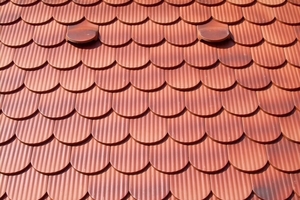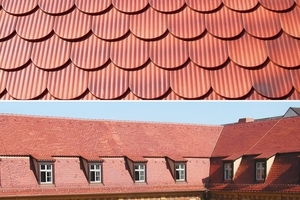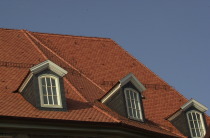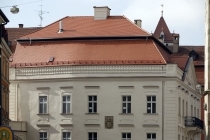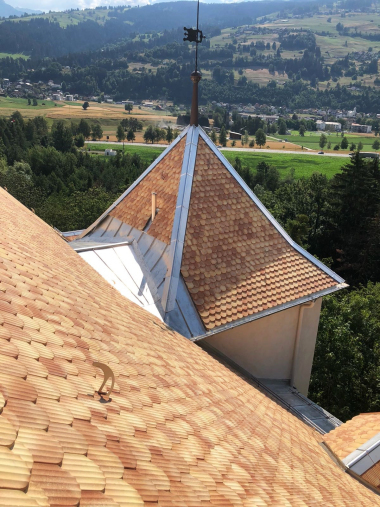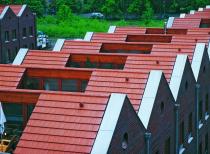Soft-mud plain tiles from Jacobi now crowning historical hospital building
Once again, the Jacobi Group, based in Bilshausen / Langenzenn, Germany, has demonstrated a wealth of experience and competence in cooperation with the monuments office and a propensity for taking object-specific approaches to tasks at hand: The roof-tile producer supplied 48,000 custom-fabricated, "soft-mud brindled" plain-tiles for renovating the roof of a historical building at Würzburg's Holy Spirit Civic Hospital foundation. Their special finish found the approval of everyone - not just of the builder / owner. "Purely positive," opines the competent monuments office in Würzburg, where the soft-mud tiles were seen as "a step forward" for ensuring authenticity in the preservation of centuries-old tiled roofs. And rightly so, for the freshly renovated roof with its new plain tiles blends harmoniously into its densely built-up, variform, roofscape surroundings.
Managing Director Dr. Michael Rückert defines the most urgent social function of the foundation (established in 1316) as working with senior citizens. The foundation operates five nursing homes, three assisted-living institutions and a geriatric rehabilitation clinic. In all, some 850 patients and occupants are being cared for in the various houses. The foundation also owns numerous real properties and a winery.
One very impressive part of the civic hospital at the centre of town is its "Red Building" a baroque wing building with an immense mansard and top roof that had housed the rehabilitation clinic since 1994. In March 1945, in the chaos of war, the hospital building burned to the ground. Then, between 1947 and 1951, it was rebuilt in stages. As decades passed, weather exposure and the ravages of time took their toll. The roofs of what is now the rehabilitation clinic developed numerous leaks, and rain was able to dribble in. The sole pieces of all 40 dormers were found to have suffered most, since dormer cheeks were rarely metal-clad in earlier times. Only the roof skeleton was still intact. In the autumn of 2005, the decision was made to fully restore the roof and to partially refurbish the façade.
Originally, the roof had been covered with natural-red, double-lap plain tiles. The monuments office specified that the new roofing should also consist of plain tiles, but with an antique-looking, soft-mud finish. Market inquiries soon lead to the Jacobi Group, where brindled plain tiles are produced, but not a soft-mud version. A sense of responsibility for the preservation of heritage buildings on the part of company president Klaus Jacobi led him to have some experimental plain tiles with the specified finish produced at the Jacobi Group's plain tile factory in Duderstadt, Lower Saxony. Using a special technique and manual colouring, a sample set of "soft-mud brindled" plain tiles were turned out - and immediately found endorsement. Hence, a special, customized run of 48,000 plain tiles with eight grooves on top were batched up, shaped, fired and sent on their way to Würzburg.
Nonetheless - before the roof could be renovated, there were some logistical problems to be solved by the foundation's administration. For one thing, the hospital building is bordered by streets on all sides, with only a narrow passage connecting the courtyard to the street network. The courtyard, as the entryway for the clinic building, is also used by visitors to the cafe and restaurant, and it proved too small for all the necessary jobsite activities. But structural engineer Volker Leukert, who was responsible for the entire project, had a brilliant idea: a big mobile crane he had parked overnight out on the street was used to heave a normal, everyday building crane over the front row of buildings and deposit it in the courtyard. (Afterwards, it was removed in the same manner.)
The old-established, family owned, local roofing company Heller GmbH was called in to rehabilitate the roof. As soon as all the scaffolding was in place, the old roof skin was removed section by section, immediately followed by installation of a sarking membrane, battens and tiles. "Whatever was exposed in the morning, had to be finished by quitting time." Volker Leukert points out, "because there were patients lying in rooms directly below the roof. Since the attic space had already been converted and finished, including good insulation, at the time of the clinic's commissioning, no additional thermal insulation was necessary. One problem, however, was how to tie in the dustpan dormers - 40 in all - which, with their minimal inclination of 12°, look like arris fillets sticking out of the top roof. Since the new roofing would be higher than the old version, which had no sarking membrane or counter battens, there were some careful adjustments to be made. For example, the monuments office stipulated that all ridges and hips were to be mortar-stabilized. Accordingly, 250 dormer ventilators were installed to ensure adequate ventilation of the roof structure. The plain tiles on the mansard roof were clamped in place. All metal parts of the roof - eaves trough, valley gutters, snow catchers, etc. - were made of copper. All the many vents from the attic-floor bathrooms were arranged on the outside of the roof - not in the ornamental façade.
Both the builder / owner and the monuments office are proud of the finished job. While the new roof of the clinic building does dominate the foundation complex, its antique-looking finish blends harmoniously into the surrounding roofscape. Another heritage-protection job well done with Jacobi plain tiles.

